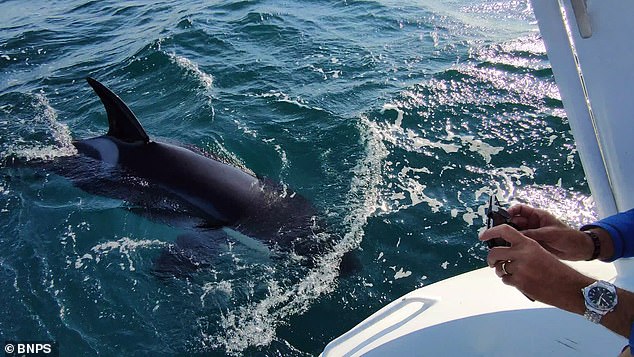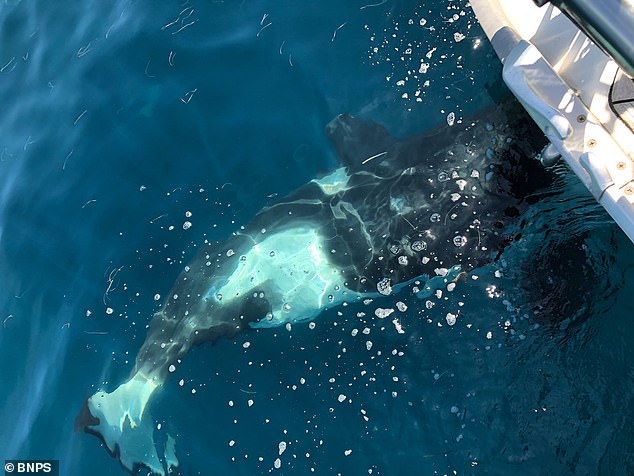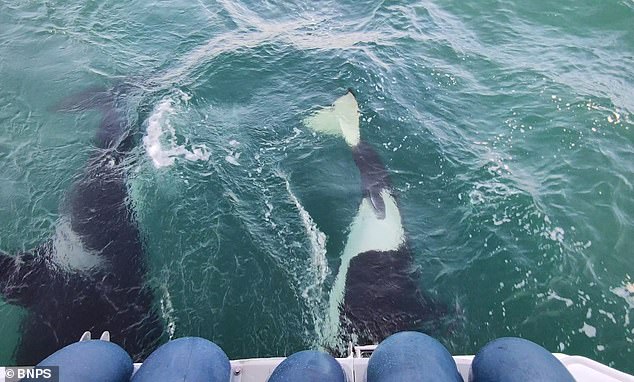Scientists solve the mystery of why orcas attack boats worldwide
Killer whales have caused chaos among boaters since 2020, ramming into the rudders of more than 600 ships and sinking many.
Marine biologists have now revealed that their apparently aggressive behavior may actually be the result of boredom among the highly intelligent animals.
In a report released Friday, biologists, government officials and other Navy representatives say boat rudders are an important plaything for killer whales in open water.
Researchers believe the sudden craze for attack boats started around 2019 after a rapid increase in bluefin tuna, the orcas’ main food source.
This meant they had spent money spend less time hunting, leaving them with plenty of free time.
In a report released Friday, biologists, government officials and other Navy representatives say boat rudders are an important plaything for killer whales in open water.
Although the reason why the attacks started has not yet been officially confirmed, marine biologists believe they started when a teenage whale played with the rudder in front of its peers, starting a trend.
“Maybe that person touched a rudder and felt like it was something fun to play with,” said Alex Zerbini, chairman of the International Whaling Commission’s scientific committee. The Washington Post.
“And after playing, the behavior started to spread among the group until it became as widespread as it is today.”
Orcas have started similar trends in the past, such as wearing dead salmon as hats and playing chicken.
The boat attacks were carried out by a group of fifteen, mainly young and teenage whales, between the ages of five and eighteen, who slowly approached the ships and allegedly pushed their noses gently against the rudder.
Marine biologists reported that although adult females were observed in the area at the time of the attack, “they just seem to be kind of watching their kids, who are doing the actual play,” Naomi Rose, a senior scientist at Animal Welfare, told Animal Welfare. Institute at The Post.

Researchers think the trend started when a teenage whale bumped its nose against the rudder in front of its peers. Pictured: A killer whale attacking Dieter Peschkes’ yacht off the coast of the Iberian Peninsula in 2021

Orcas have started similar trends in the past, such as wearing dead salmon as hats and playing chicken. Pictured: A killer whale attacking Alan Bruce’s yacht off the coast of the Iberian Peninsula in 2021

The report says that killer whales are known to play with other objects or animals in the sea, but can go overboard and in some cases kill the object of their entertainment. Pictured: Two killer whales attack Dieter Peschkes’ yacht off the coast of the Iberian Peninsula in 2021
Researchers believe their boredom stems from the abundance of food on the Iberian Peninsula, where the attacks occurred mainly off the coasts of Portugal, Spain and Morocco.
In 2019, orcas faced food shortages as the population of their main food source, the bluefin tuna, declined, causing them to spend most of their time hunting and eating whatever food they could find.
But after the bluefin tuna population recovered the following year, whales no longer had to spend all their time looking for food, leaving them with nothing to do.
“The sea is a very boring place for an animal,” said Renaud de Stephanis, president of CIRCE (Conservation, Information and Research on Cetaceans), an organization dedicated to the conservation of marine life. USA today.
‘Imagine you are a dog or some other mammal, you can interact with objects around you. But in the sea there isn’t much for the orcas to communicate with, so they play with the rudders,” she said.
The report said that killer whales are known to play with other objects or animals in the sea, but can go overboard and in some cases kill the object of their entertainment.
“…In the southern killer whale population of Washington, USA, which feeds on salmon, individuals will ‘play’ with porpoises to the point of being killed, which may represent a similar escalation of an initially less harmful interaction,” it said report, adding, “So this behavior seems to fall within that spectrum.”
The researchers warned sailors against taking it upon themselves to launch flares and other devices to scare the whales, saying this could only make the game more fun for them.
Instead, they suggest making the rudders less fun for the orcas to play with, or removing them altogether if possible.
The group is working on alternative methods to replace the smooth surfaces of the rudders with bumpy or abrasive materials and devices that make loud noises, such as banging noises, to deter the whales from approaching.
In the report, marine biologists also advise boaters to travel around killer whale hotspots to mitigate an attack before it happens, with the caveat that whales are constantly migrating, so predicting where they will be is not 100 percent successful.
“We don’t want any more boats to be sunk and we don’t want any more people to be in distress,” Zerbini told The Post.
‘But we don’t want the animals to get hurt either. And we have to remember that this is their habitat and we are in the way.”
Since ships were advised to flee from any potential whale interaction in May last year, attacks have fallen by 70 percent.
